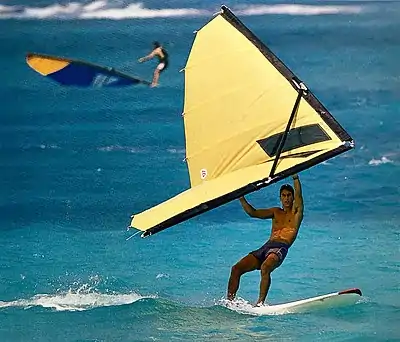Wing foiling
Wing foiling or wing surfing or winging is a wind propelled water sport that developed from kitesurfing, windsurfing and surfing.[1][2] The sailor, standing on a board, holds directly onto a wing. It generates both upward force and sideways propulsion and thus moves the board across the water. The recent development of foilboards, which plane very early on a hydrofoil fin and thereby lift off the water producing low friction, represent the ideal complementary hydrodynamic platform for wings.[3]

History
Precursors

The history of wing foiling, or simply "winging" begins with the invention of pre-hydrofoil technology wing surfing dating back to 1981, when aeronautical engineer Jim Drake, the same individual who also invented windsurfing,[4] and Uli Stanciu, European windsurfing pioneer, together invented and patented the world's first wing.[5] Their patented concept was used on a large, non-foiling windsurf board of that era. Drake's wing was theoretically based on the symmetrical shape of a flying fish. 15 years after Drake originally invented windsurfing in 1967, his updated, newer wing concept was different because it was not fixed to the board via a mast and universal joint.[5]
Soon after, a frenchman named Roland Le Bail designed a similar wing design. In the years that followed, new technology was adapted and wings repeatedly came onto the market in different variants. In 1986 a mast borne winged concept called Wind Weapon allowed for high jumps in locations with strong wind and but like Drake's first wing, it was pre-hydrofoil technology and never gained popular support.
The use of the wings is not exclusively tied to water sports, but are also used for sports on the snow, on the beach or on land. The designations "Skate Sails", "Wind Skates" or "Kite Wings" should be mentioned as milestones in further development. What most of these variants have in common is that they use a stiff frame to stretch the wing, which also acts as handlebars or handles.
The reason for the moderate success of all these developments is a physical one: friction. Wings that are big enough to move a sluggish traditional board (including the rider) have to be big, unwieldy and heavy. Newer lightweight, efficient, inflatable wings offers enough propulsion when combined with foilboards[6] to allow excellent performance characteristics.
Modern form
Tony Logosz, Slingshot Kiteboarding co-founder & designer, made the first "Slingwing" prototypes in 2011, and used it on a wind foil board with a large, high-lift foil in the Columbia Gorge.[7] In March and April 2018, Hawaiian Flash Austin tested 3.5 m² and 4 m² handheld wings on a SUPfoil in Maui.[8][9] Inspired by Flash’s success, Ken Winner began working on inflatable wings again and the sport as we know it was born. Duotone started marketing their Ken Winner-designed inflatable wing in the spring of 2019.[10] From the summer 2019, Robby Naish and other kitesurf manufacturers were offering inflatable wings.[11]
Construction

The young sport is still developing. While older wing models were often stretched and held by means of rods, the influence of kite development is currently becoming increasingly important: The wing is made of light kite fabric, which is stretched by inflatable air tubes. To grip the wing, some brands use struts with hand straps, others use aluminium or carbon fibre poles.
Deployment variants
In contrast to other sports, the wing is not board-bound: it can be used while riding a surfboard, kiteboard or standup paddle board, but also in combination with a skateboard, snowboard, or even on inline skates. Wingsurfing on boards equipped with a foil is particularly popular, as it is possible to plane with small wings at around 8 knots. Wings come in different sizes; typically the smallest are around 2.2 m2, and the largest around 9 m2.[12]
Organization
Wing surfing companies have founded an organization for the sport called the Global Wingsports Association (GWA).[13] They have organized a world tour starting in 2021. There are two disciplines: surf-race and surf-freestyle.[2]
Classification in the existing surfing sports
Technically, but also in terms of application, wingsurfing has numerous similarities to both windsurfing and kitesurfing. For example, the wing is controlled directly instead of using lines, but it still has a similar construction and functionality to a kite. The question of whether wingsurfing is a variation of kitesurfing, windsurfing or a completely independent sport is not just of a theoretical nature: it also concerns, for example, the extent to which kite bans at the spots also apply to wingsurfers.
References
- "Winging – what is it and how do I get started?". www.rya.org.uk.
- "Wingfoil World Tour announced for 2021". Surfer Today. December 14, 2020.
- Clothier, Chris (June 18, 2021). "The only way is up: the irresistible rise of wing foiling". Financial Times.
- "Origins of Windsurfing: Jim Drake". American Windsurfer. 2015-12-06.
- Stanciu, Uli (Feb 15, 2021). "The story of Jim Drake's first "Wing" rig". Surfertoday.
- "What is wing surfing?". Surfer Today.
- "New Slingwing Brings Easy Crossover from SUP to Windsports". SUP Connect. May 5, 2019.
- "First Ever Wing Foiler". Wingsurfing Magazine. March 28, 2018.
- "Flash Austin testing a new Handheld 4m Windweapon and foil on Maui, Hawaii". straplesskitesurfing. 2018-04-17.
- "The Not-So-Short History of Wing Foiling". Wingsurfing Magazine. Jan 20, 2022.
- Museler, Chris (September 8, 2020). "The Rise of Wing Sailing". Sailing World.
- "How to choose the right wing foiling equipment". Surfer Today. November 4, 2020.
- "Introducing the Global Wingsports Association (GWA)". Global Wingsports Association.